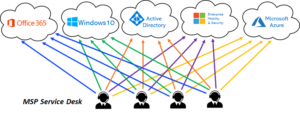As the fight against the Coronavirus rages on, Managed Service Providers are trying to understand how this global pandemic will affect their Managed Services business moving forward. Many questions are still unanswered, many will remain unanswered for quite some time as this new “normal” continues to evolve throughout 2020. What is becoming clear is that the global customer shift to a Remote Workforce is accelerating adoption of Public Cloud. This is creating a unique set of new challenges for many MSPs, specifically identifying new workflows and tools that will be required to support these Public Cloud consuming customers.
The Current MSP Climate
Historically, MSPs have had a well-defined suite of tools (think PSA & RMM) for managing all things on-premise. While PSA tools can easily make the transition to a Public Cloud world since they’re environmentally agnostic, RMM tools cannot. For the MSP, they will need to identify and standardize on a new set of processes and tools to remotely manage their customers and the SaaS applications they’re consuming, starting with management of the most globally consumed SaaS business application – Microsoft 365.
MSPs do have the option to standardize their Microsoft cloud managed services practice on the administration tools that comes with Microsoft 365, which are free. However, these tools aren’t remotely (no pun intended) designed with the MSP in mind. They don’t address the management complexity that comes with concurrently managing 10, 25, 50, maybe 100+ customers at a time, across all the different Microsoft 365 applications that they consume. As a result, the Microsoft administration tools force MSPs to manage all Microsoft 365 customer tenants on a customer by customer basis.
The Administration Challenge

Each customer has their own unique Microsoft 365 tenant and leverages multiple applications. Each individual application within Microsoft 365 (O365 Exchange, SharePoint, Teams, Intune…) has its own unique administration portal, separate logins, their own unique administrative approach and a severe lack of security controls. This mass of administrative inefficiency not only inhibits efficient remediation of customer cloud support tickets, it also exposes significant security vulnerabilities, which ultimately combines to erode an MSP’s service margin and severely limits their ability to aggressively scale a Microsoft cloud managed services business.
As MSPs attempt to plan for the future as this pandemic continues to create business unknowns, one thing is very clear – a new set of processes and tools will be an absolute requirement in this new Public Cloud world. In addition, service delivery efficiency will be critical to an MSP’s profitability, and ultimately, their ability to survive. Service efficiency is maximized only when Service Automation is at the core.
When adopting a new set of tools to optimize service delivery of Public Cloud, and in particular the Microsoft cloud stack, it is essential in identifying a solution that, as a bare minimum, provides true Multitenant Management capabilities. In doing so, MSPs can decrease the amount of time required by their services delivery teams to perform routine administrative tasks.
Multitenant Management is just the tipping point of what’s required for service automation in a Microsoft Cloud Management Platform. A management platform that includes extensive service automation leads not only to higher efficiency for MSPs but higher profit margins through reduce remediation time and increased customer satisfaction. So, through automating the process of managing multiple Microsoft tenants within a “Single Pane of Glass” portal, MSPs can further accelerate their cloud managed services business.
Final Thoughts
The way that MSPs are managing all their customers (or tenants) is rapidly changing – due in large part to the accelerated adoption of cloud services from the current pandemic. Being able to effectively and cost efficiently manage all these tenants should be something at the forefront of every MSP’s strategic vision moving forward. How MSPs begin to implement an effective solution must begin with aggregating all their tenants into a single pane of glass portal. This way MSPs can have easy and swift access to all their tenants without having to hop through multiple portals. From this, MSPs can begin to establish service automation for their tenants. This allows them to take the first – and most important – step towards building for a cloud-first management future.